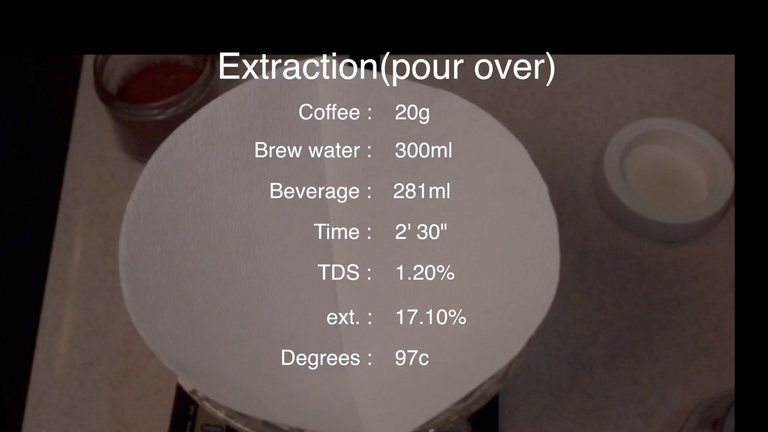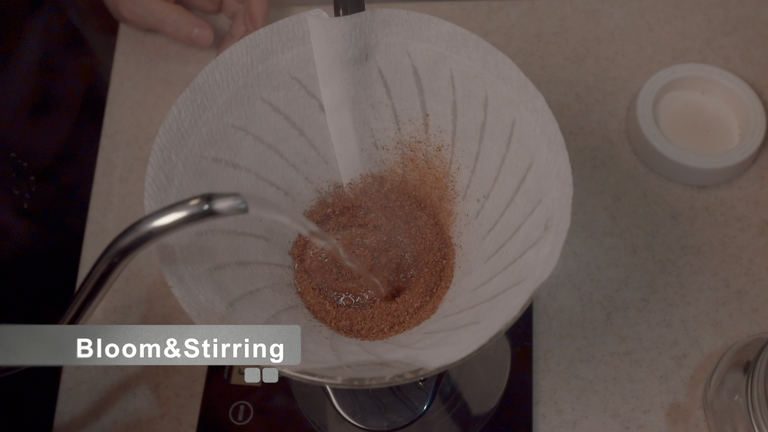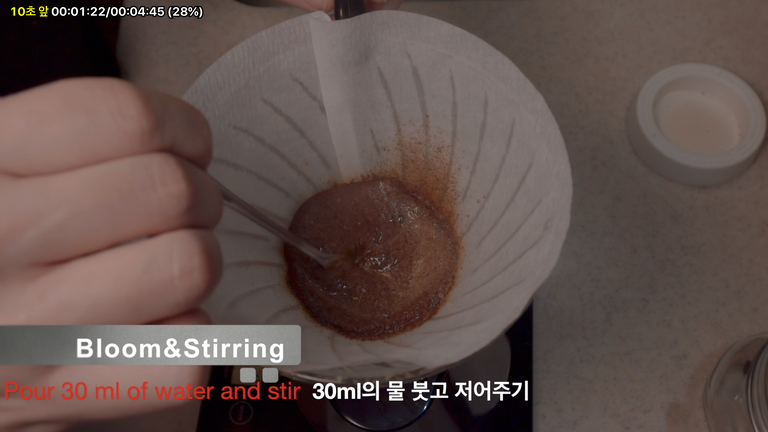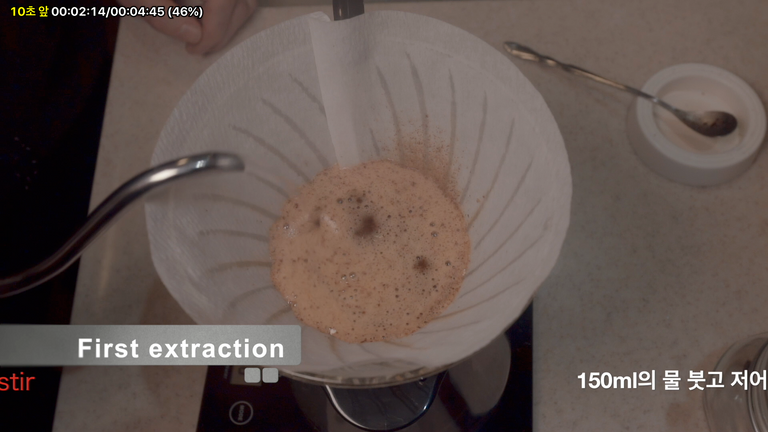Good morning. I posted only coffee roasting every day, but I would like to write about extraction today. There are various factors that determine the taste of coffee.
Bean cultivation and harvest method, green bean storage, roasting, bean extraction
Through these processes, a cup of coffee comes into our hands. When each of these elements changes, the taste of the coffee changes. Extraction can also make such a change. For example, a variety of roasted green beans that taste good with a buttery feel can be reduced by controlling the extraction. On the other hand, it is possible to slow down the acidity by controlling the extraction of strong and bright acidified beans. You can control the basic light taste of coffee and the taste of darkness to some extent.

Pour-over extraction is one of the easiest ways to extract coffee at home. With a little interest and control, I have the advantage of expressing the coffee feel I want. The hand drip is slightly different from the hand drip. The hand drip is slower than the dripping hot water by carefully adjusting the flow rate. Hand Drip has the advantage of controlling various flavors according to the personality and skill of the extractor, but it can be difficult to adjust the taste and concentration of coffee if it is wrong. On the other hand, PourOver has the advantage of being able to extract good flavor even for those who first contact the coffee by adjusting the extraction time, grinding, and extraction amount to some extent. But there are lots of things to worry about in both ways. Let's take a look at the various figures in the photo above.
coffee
The amount of bean used in the extraction. Weighing is essential to maintain consistent taste balance. You can maintain a nice balance of taste even if you follow only the weight and temperature of the professional barista.
Brew water
The total amount of water to put into the coffee powder. It means that 300ml of the total was poured and extracted. We used 300ml of water for 20g of bean, but the ratio of bean and water is 1:15. Usually the preferred ratio is 1:15 to 17 in the café. There are many places where 1:10 ~ 12 are used to pursue a deep style of coffee.
Beverage
It is the amount that comes out when we put 300ml of water. This means the amount of coffee that can be extracted completely and put in our hands.
Time
The total time spent extracting. Basically, it is easy to extract in order of sourness - sweetness - bitter taste. In other words, on average, the shorter the extraction time, the better the sour taste than the bitter taste. Conversely, if you continue to increase the extraction time, you will get more caffeine extracts and more components such as bitter taste.
If you use this principle well, it is easy to extract coffee according to my taste. If you have a sour taste and you want to increase the extraction time, you will feel less acidity. (Sour taste is extracted first, then sweet taste extraction is done in the second half, and taste is neutralized. In contrast, you can choose a method to reduce the extraction time so that you can feel the sourness of the bean that lacks sourness more and the bitter taste.
TDS
Abbreviation of Total Dissolved Solid, meaning coffee solids dissolved in coffee. If the TDS is too low, the coffee will feel less, and if it is too high, the balance of coffee flavor will be broken and extracted, making it difficult to feel the correct taste. Usually 1 ~ 1.6% of the extraction is done to fit.
ext.
The extraction yield. What is the total amount of ingredients extracted from the coffee powder? If the extraction yield is too low, the coffee flavor will become tender and it will be difficult to feel the correct taste. On the contrary, if the extraction yield is high, the bad bitter taste of the bean, the taste of the wood, and other unpleasant flavors are extracted together. Usually, it is about 17 ~ 22%, and it is extracted, and the yield is controlled according to the taste and kind of the bean.
Degrees
The temperature at which water is first introduced. For best accuracy, it is best to use a drip port that keeps the temperature constant, such as Bonavita. However, since the boiling water is usually put into the ordinary drip port and extracted, the temperature decreases with time. Traditional temperatures range from 88 to 93 degrees. Weakly roasted beans are advantageous to keep the flavor balance by extracting higher water temperatures.
==============================================================
Let's take a look at the extraction order.
We used roasted coffee beans from Burundi AA Specialty. Because the roasting time and DTR are very short, I increased the water input temperature somewhat higher than usual.

Rinsing
Rinsing. The first step is to soak the paper in water. Some people do rinsing, others do not. I usually do rinsing to reduce paper flavor.


Bloom & stirring
To extract the ingredients of the bean more easily and to remove unnecessary gas in advance. Add 1.5 to 2 times as much water as the beans and lightly stir. The reason for stir is to make enough water to reach the bottom bean powder.

Wait a moment. Usually it takes about 30 ~ 40 seconds. In case of roasted beans with short DTR, it takes longer time.



Extract
Start extracting. It is best to use the balance or you have to adjust it with the scale of the drip server. Since the target of water injection is 300ml, we will divide into 150ml twice. Though it is not specially decided, I usually split water twice. You can adjust the total extraction time by decreasing or increasing the number of times the water is filled.
It causes turbulence after water is introduced. The turbulence is turned by a spoon, while the surface is slightly twisted, and when the water is stirred, the water rotates down due to the rib shape of the Hario Dripper. The reason for this turbulence is to take the extraction more aggressively and extract it evenly for each bean particle. Turning more aggressively to the ground beans, turbulence will increase the extraction yield. If you want to extract a thicker, larger amount of coffee flavor, aggressively mix water and bean flour and wait for the water to spin. But if it is wrong, it can be extracted and the bad taste can be extracted.
The extraction is usually completed in 2 to 3 minutes. Depending on the roasting / grinding / aging conditions, the time is shorter and longer. Like a cooking recipe, you can get a consistent taste by adjusting the extraction time, the amount of bean / water, and the temperature of the water.
I will stay here today. I will post about the pour-over setting method according to the degree of roasting next time. Thank you for reading the long story. :)
진짜 멋지신 분 ㅠㅠ
^-^;;;; 저 말씀하시는거 맞죠?? ㅋㅋㅋㅋ 이런 칭찬을 별로 들어본 적이 없어서 잠시 즐기겠습니다. 사심많이 들어간 풀보팅도 드립니다. 제겐 너무 멋진 단어가 들어있는 컨덴츠네요 ㅋㅋㅋ
전 씨마님 포스팅보고 늘 반한답니다!!~ 고마워요. 제게 좋은 걸 많이 주셔서~
앗 당연히 울랄라님이죠.
진짜 멋지다고 생각해요.
요리를 프로페셔널하게 접근해서 소개시켜주시는 것..(뭔가 기술적이고 과학적인 뷰로도)
하나하나 설명해주는 방식...
이렇게 영어로도 유창하게...ㅠ
제가 항상 감사드립니다. ㅠ
아~ 같은 포스팅에 한국버젼 영어버젼이 있군요 ㅎㅎ뭐 어느나라를 가도 커피는 존재하니 유용할것같은데요 ? 근데요 제가 일본에서 커피를 먹는데 아닌곳도 있지만 전체적으로 신맛이 나는곳이 더많더라구요 그리구 두잔을 시켰는데 한잔은 신맛 한잔은 쓴맛이 엄청강하더라구요 이런건 이해가잘안가요 같이주문해서 나온건데 어찌 그렇게 되는건지 하~ 커피는 어려워요 ㅎㅎㅎ 전 신맛이 아직 적응이안되어있어서 신맛이 좋다는사람도있는데 근거가있는말인가요?
네 신맛이 많다는 건 로스팅을 짧게 가져가서 커피콩의 발현을 적게 가져갔다는 뜻입니다. 커피콩의 발현을 적게 하면 탄맛과 쓴맛은 거의 느끼지지 않아요. 대신 신맛은 극대화되면서 원래 커피콩이 가진 향미와 맛이 고스란히 남아있을 수 있답니다. 생두의 품질에 자신이 있고 본연의 맛을 보고 싶을때 약배전을 주로 많이 합니다. 신맛과 커피콩의 개성있는 맛을 거의 같이 간다고 보시면 됩니다. 하지만 잘못하면 신맛이 지나치게 부각되어 맛의 밸런스가 깨어지고 거부감이 드는 맛이 될 수도 있기 때문에 로스팅 정도를 조금씩 조절하면서 신맛베이스에 다른 맛들이 잘 보조할 수 있게 로스팅을 신경써서 조절합니다 ^-^
예전엔 배전도를 높여 탄맛과 구수함, 오일느낌의 풍미를 살리는데 주력했고 일본이 이런 스타일을 잘 표현했습니다. 거기에 일본 특유의 단맛을 좋아하는 취향과 함께 탄맛과 쓴맛, 단맛의 밸런스를 잘 맞추는 커피가 발달했으며 초창기 우리나라에 커피가 들어왔을때도 그런 스타일이 주를 이루었습니다. 지금은 좀 더 다양화되어 거의 볶다만듯한 약배전 커피부터 탄화에 가까운 강배전 커피까지 다양하게 제품화되어 나오고 있습니다. 그리고 로스팅뿐만 아니라 추출의 비중도 많이 늘어나서 추출하는 방법에 대한 연구도 많이 이루어지고 있어요.
신맛을 좋아하시는 분들은 가볍고 끝이 달달한 느낌의 커피를 좋아해서일거라 생각합니다. 맛있는 신맛커피는 신맛 다음에 단맛이 느껴지거든요. 이 때 단맛은 설탕같은 느낌이 아니라 맨밥이나 미숫가루를 먹을때 조용히 느낄 수 있는 은은한 느낌의 단맛입니다 ^-^
역시 영어는 패스입니다 ㅎㅎ
커피 20g이면 진짜 진하게 한 잔 나오겠네요 ^^
아 ~ 맛나겠어요 ~
이런 것을 세밀하게 기록으로 남겨놓아야 같은 맛을 낼 수 있겠군요.
역시 멋집니다 ~ ^^
많이 배웁니다.
그리고 ~ 저 밝은 커피 색을 보니 산미가 돋보이겠네요 ~ ^^
뜸들이기를 1분 한다는 것은 처음 듣는 이야긴데 푸어오버 에서의 방법이군요 ^^
이것 또한 어떤 맛일지 궁금합니다.
깔끔한 맛이 덜하다는 말 때문에 해보지 못하고 있었는데 궁금증을 유발시켜주셨습니다.
보통 뜸을 들이는 이유는 가스를 빼고 추출을 용이하게 하기 위해서인데, 뜸들이는 시간이 길어질수록 추출이 수월해집니다. ^-^ surfergold님이 평소 즐겨하시는 무거운 느낌의 강배전 커피는 DTR(Development Time Ratio)가 높기 때문에 원두 입자 안의 구멍이 많이 나있어 추출이 잘되는 편입니다. 그래서 뜸들이는 시간을 다소 줄이시는게 좋고 반대로 약배전 원두들은 추출이 어렵기 때문에 뜸들이는 시간을 의도적으로 길게 가져갑니다.
글에서 사용한 브룬디 원두의 경우 1팝 시작 후 20초 정도 뒤에 종료했기때문에 약배전 중에서도 아주 약배전인 원두입니다. 그래서 충분히 뜸들이는 시간을 주는편이죠. 그렇게 하지않으면 추출이 수월한 신맛이 먼저 추출되지만 단맛이 덜 추출되어서 신맛-단맛의 밸런스가 깨어지는 커피가 됩니다. 단맛이 없으면 신맛이 너무 강해져서 맛이 불쾌해질 수 있습니다.
또한 커피맛 평가에서 맛의 complexity는 굉장히 중요한 요소입니다. 신맛, 단맛, 풍미, 쓴맛, 짠 느낌 등의 다양한 맛들이 균형있게 어우러져야 한 잔의 맛있는 커피가 된다고 볼 수 있습니다. 저번에 말씀드린 박윤혁 선생님 커피에서도 쓴맛만 있는게 아니라 그 쓴맛을 충분히 맛있게 느끼게 도와줄 수 있을만큼의 강한 단맛과 풍미가 있었습니다.
앗! 그리고 난류를 보다 적극적으로 일으키시면 깔끔한 맛이 덜하고 혀의 텍스쳐가 좀 더 잘 느껴지는 커피가 추출됩니다(혀가 까끌까끌 ^-^) 반대로 난류를 동영상처럼 표면에만 살짝 일으키면 좀 더 클린하고 깔끔해지니 참고 바래요!! 홧팅!
정말 대단하십니다.
로스팅에 대해 정말 박사십니다.
오늘 너무 많은 것을 배워 다 기억하려나 모르지만 약배전은 뜸을 더 오래들여라는 말씀은 까먹지 않을 듯 싶습니다.
그럼 말씀주셨던 것처럼 단맛이 별로 없는 품종을 약배전으로 가면 조금 밸런스가 안맞을 가능성이 높겠군요.
난류라... 아 ~ 어렵네요.
참 좋은 정보들 감사드립니다 ^^
티스푼으로 휘저휘저~ => 난류입니다 ^-^ 원두가루 아랫쪽은 과추출되고 윗쪽은 과소추출되는 경향이 있어서 그냥 포크레인으로 땅파듯이 2~3회 뒤적뒤적거리고 표면 한바퀴 돌려 회오리 일으켜주시면 됩니다. 싱거우면 4~5회, 진하면 1~2회 혹은 그냥 회오리만 일으키시면 됩니다.
강배전은 의외로 입자를 크게 그라인딩해서 85도 내외의 물로 아주 천천히 내리셔도 매력있는 커피가 나온답니다 ^-^입자가 크면 과추출은 억제되고 강배전 특유의 풍미는 느낄 수 있게 커피를 내리는데 도움이 되니 참고하세요! 홧팅
감사합니다.
이런 고급 정보 참 좋습니다.
덕분에 많이 배웁니다 ^^
좋은 하루 되세요.
arabica coffee?, or robusta..
I used Burundi AA Specialty, Mungkaze(arabica coffee) :)
Wow high quality coffee friend..
동영상에 한글이 나오네요 ㅎㅎ 잘보았어요^^
ulalla98님 오늘하루도 즐거운 하루보내세요^^
감사합니다 ^-^!!
오호 이번에도 영어네유 ㅋㅋ 파이팅입니닷!
좋게 봐주셔서 감사해요 ^-^!!
다시 보는 글이지만 커피향이 솔솔 나는 것 같아요.^^ 기분 좋은 포스팅!
주말이네요. 비가 오는 날에 울라라님은 창밖을 바라보며 커피한잔 하고 있을 것 같아요~ 행복함이 묻어나는 주말되세요^^
우풍이 심해서...이불 둘둘말고 커피마시고 있습니다 ㅋㅋㅋㅋㅋ 멋있게 봐주셔서 감사해요!
waaaaw cool once so like ..! brother please follow back and vote also ya brother